A Guide to Rosé: What it is, How it is Made and What it Pairs With
April 11, 2023
In this guide learn how pink wine is made, how the grapes & colors define the taste & what rose pairs well with in each season!
Although Rosé wine has been enjoyed for centuries, its popularity has surged in recent years, and we now celebrate with phrases like “Rosé all Day” and “Yes Way Rosé”. The French even have their own term “rosé tout l’année” which translates to “Rosé all year round”. We’ve even got the boys covered with “Brosé”, which Urban Dictionary defines as “Pink wine enjoyed with friends, or your bros”. With this rise in Rosé drinking culture, we wanted to share some fun and educational information to get you ready to Rosé your day away.
How is Rosé still wine made?
Even through Rosé wine is made using red wine grapes, the winemaking process differs slightly from that of red wine. The grapes are crushed and left to soak with the skins for a shorter period than in red wine production, typically 2-20 hours. This results in a pink wine with a lighter flavor profile than red wine. There are 4 methods for producing rosé wine: maceration, saignée, direct press, and blending.
Maceration – This is the most common method and involves crushing the grapes and allowing them to rest, or macerate, in their skins for a short period of time. Macerated rosé leans toward deeper hues and fuller-bodied rosé.
Saignée – The saignée method is less common and involves “bleeding off” a portion of red wine juice during the fermentation process and using it to make rosé wine.
Direct Press – This process drains the pressed juice off the skins pretty much immediately, resulting in a very light pink hue and brighter flavors.
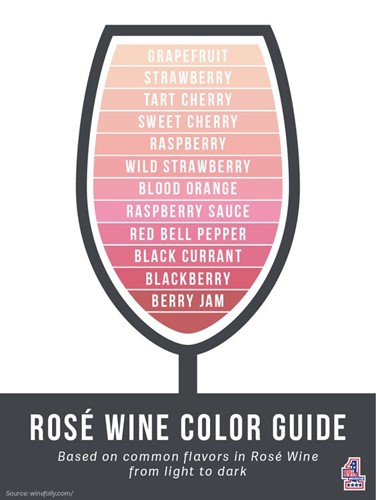
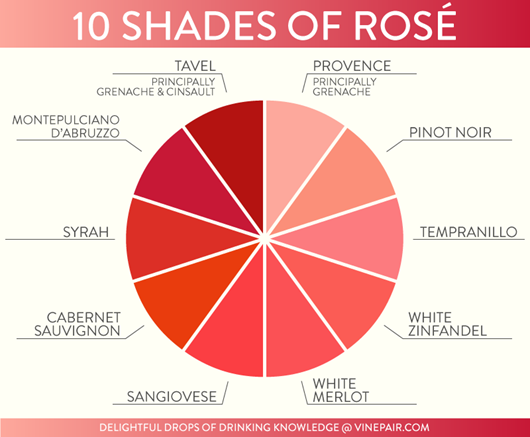
Blending – This method is a literal blend of white and red wines and is most common in the production of rose champagne and rosé sparkling wine.
Rosé wine can be made from a variety of grape varieties, including Grenache, Syrah, Pinot Noir, Cabernet, Sangiovese, and Cinsault, to name a few. Each grape variety brings its own unique flavor profile to the wine. Grenache grapes, for example, are known for producing a rosé with a fruity, strawberry flavor, while Syrah grapes produce a more robust, full-bodied rosé.
Does the color have an impact on the flavor of Rosé? Although the shade of rosé will not define the sweetness or dryness of the wine specifically, it will give you insight as to what you can expect from the flavor profile and hint at what grapes were used in the process. The lighter the color, the closer towards a white wine the flavor will be, think citrus, floral, and mineral notes, and clean finish, whereas the darker the colored rosé’s will be fuller bodied and have more red berry and earthy notes.
To learn more about the regions and grape varietals check out this awesome article from Vinepair.
How and when to drink Rosé and what to pair pink wine with
Rosé is versatile and perfect for any occasion and pairs well with a variety of foods including seafood, salads, and light pasta dishes. It can be enjoyed year-round but really shines in Spring, Summer, and Fall and is perfect for any outdoor gathering. It is also great as an aperitif, a fun wine-based cocktail (which means less alcohol) and is perfect for any picnic or charcuterie board or pairing with spicy dishes or Barbeque.
Rosé is shining in the world of cocktails and pairs beautifully with citrus, fruits, and other spirits. For inspiration and recipes check out Elle Décor’s 25 Rosé Cocktail Recipes.
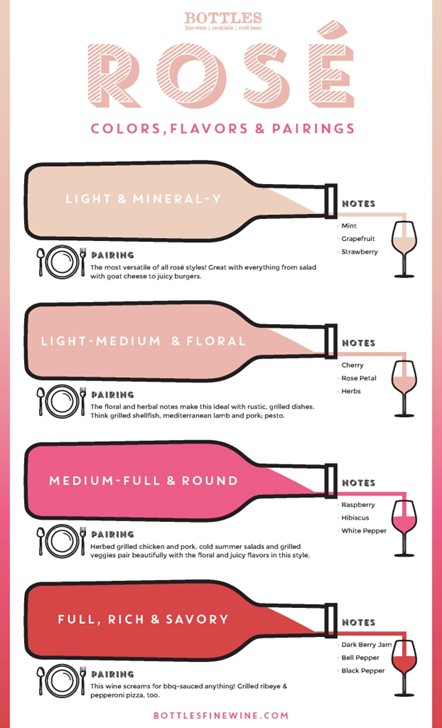
What are the types of Rosé Wine Grapes
Red grape varieties are used to make rosé, as the skin contact and saignée methods reduce the red color in the wine. So grenache, syrah, cabernet sauvignon, tempranillo, sangiovese, malbec, mourvedre, carignan, zinfandel, cinsault, and pinot noir are all common varieties used for rosé and even blends.
Even though rosé wines tend to the lighter side, they still offer a lovely range of sweet to dry or even hints of spice or a savoriness, and we like to think of them as a great ‘tweener’ wine as they are a perfect balance of offering the lighter profile or a white wine, while also providing more structure and depth for those that are fans of red. The flavors lean on the fruity side, so you can expect notes of strawberry, citrus, melon, raspberry, cherry, and fresh flowers.
Rosé wine blends are made from a combination of different grape varietals. Some rosé wines lean more heavily on specific grapes, which create subdivisions, or different “types” or “styles,” of rosé. Each type of rosé wine has a slightly different flavor profile depending on the grapes used.
- Provence rosé hailed as the most versatile of rosés, the Provence rosé is a wonderful choice for any occasion. It’s some of the best rosé you can get, and it’s primarily produced in Provence, France—hence, the name. There are however adjacent regions in the Sud (South) de France or what’s known as Pays d’Oc – Indication Géographique Protégé, like our Tres Chic Rosé. This fruity and light wine pairs well with any cuisine and its simple combination of strawberry and rose petal flavors makes it easy to enjoy on any occasion, from relaxed to formal, especially since it pairs well with a broad range of cuisines. Shop Now, or Click to learn more
- Sangiovese rosé is generally an Italian wine, and is fruity but dry. Tasting notes: rose petal, green melon, strawberry, pomegranate, cranberry with acidic finish. A bright, dry rose, Sangiovese rosé gives a wake-up call to dormant taste buds. Its powerful citrus notes and acidic finish take over with a full, refreshing orchestra of flavor.
- Tempranillo rosé is often a Spanish variety and is savory, dry, and has a fruity, yet meaty flavor profile. Tasting notes: watermelon, raspberry, green peppercorn, grilled chicken. A popular rosé in Spain, Tempranillo rosé blends a unique profile with both fruity and meaty notes. On the savorier side, this dry rosé is the perfect addition to a summer barbecue!
- Syrah rosé is a bold, dry wine with notes of olive and cherry. It does not need to be served as cold as most rosé wines. Tasting notes: cherry, olive, red pepper flake, lime zest, cured meat. Syrah rosé packs a bold, robust flavor as it’s more full-bodied than most other rosés. This isn’t your typical fruity rose, if you’re looking for a more daring, adventurous choice, Syrah rosé might be just the one.
- Cabernet Sauvignon rosé is savory, dry, and tastes much more like red wine than most other rosé wines. Exclusively made with the saignée method, it’s an excellent choice for red wine connoisseurs foraying into rosé. It is more acidic than regular cabernet sauvignon with notes of black pepper, black currant, cherry, and spice. The most similar rosé to red wine, Cabernet Sauvignon rosé often features a deeper shade of pink. Blending spice with the flavor of ripe cherries, this rosé has higher acidity than Cabernet Sauvignon red wine, which gives it a light yet robust taste.
- White Zinfandel Rosé is a type of sweet rosé with moderately high acidity levels. Flavor notes of white zinfandel are lemon, melon, strawberry and even cotton candy. White Zinfandel will cure a sweet tooth with its high acidity and candied fruit taste. While some types of White Zinfandel can be on the drier side, most are known for their luscious, sweet an easy choice.
- Tavel rosé is robust, savory, rich, and very dry. A little ambiguous when it comes to tasting notes, Tavel rosé hits the spot for a dry, savory wine. Tavel has distinct fruit notes, berry, but with an earthier and nuttier twist. Lower in acidity than other rosés, Tavel is known for being higher in alcohol content, usually with a minimum of 11%. Similar to the vibrant characteristics of red wine, Tavel holds a strong berry flavor with its earthy undertones.
- Mourvèdre rosé is a full-bodied rosé with initial floral notes that transform on the palate into a rich cherry, smoky, and meaty flavor. Mourvèdre rosé is a full-bodied rosé with a rounded flavor profile consisting of violets, red plums, smoke, meat, rose petal. With deeper fruit notes like plums and cherries, hints of smokiness and meat can show up as well. An excellent pairing for Mediterranean or Greek cuisine, Mourvèdre is sure to please a refined rosé drinker.
- Pinot Noir rosé is a delicate and crisp rosé with notes of crabapple, strawberry, and melon. Bright and crisp, Pinot Noir rosé defines a sophisticated and airy choice for the wine connoisseur. Although it embodies sweet characteristics, its acidity level lends to a drier taste. Enjoy a fresh glass of this rosé with lighter dishes like tapas, seafood, and salads.
- Rosé Champagne, or sparkling rosé, is champagne blended made with red grapes. Rosé Champagnes or sparkling wines are a little stronger in flavor profile than traditional Champagne. The taste will vary depending on the red wines chosen, but most will have a powerful strawberry and raspberry flavor. Our Le Grand Courtage Brut Rosé French sparkling wine consist of Chardonnay, Ugni Blanc and Gamay, a delicate red grape that offers strawberry, raspberry and lilac. Shop Now, or Click to learn more
- Grenache Rosé Bursting with fruit flavors, Grenache is usually dry and best served cold. With balanced acidity and tannins, fruity notes shine through for a delightful, rich taste. Popular in Provence and Spain, Grenache rosé has tasting notes of orange, hibiscus, strawberry, watermelon, and lemon and might be just what you need to fulfill your wanderlust.
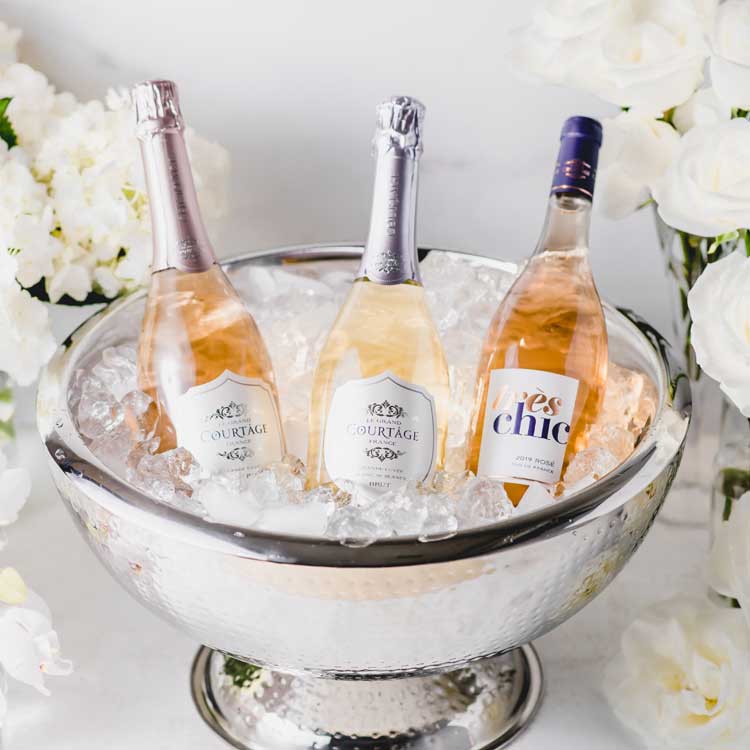
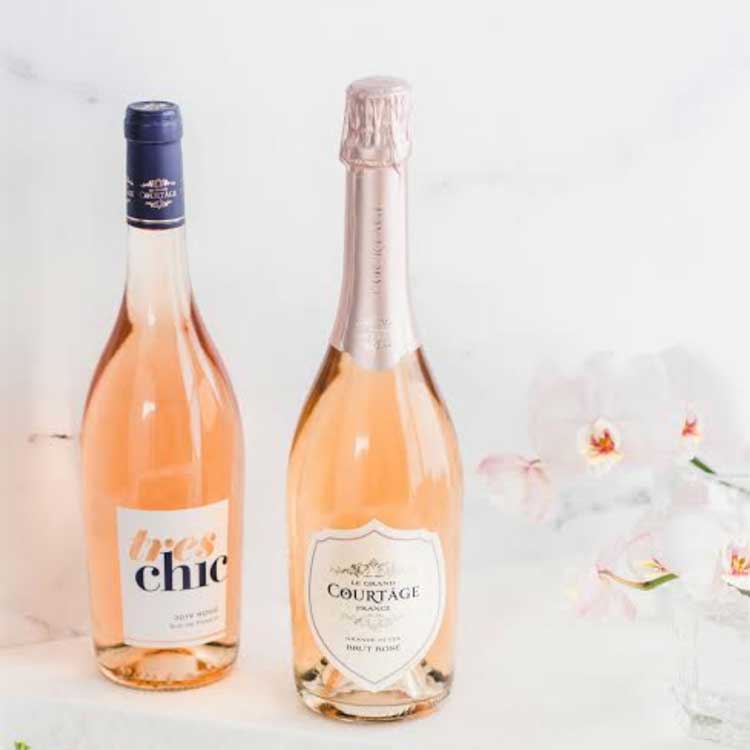
Unlocking the Perfect French Rosé Wine Pairings for Every Season
Not JUST for Summer!
French rosé wine, with its delicate hues and refreshing taste, holds a timeless charm that transcends seasons. Whether it’s the vibrant blossoms of spring, the sun-drenched days of summer, the crisp air of autumn, or the cozy evenings of winter, there’s a perfect French rosé to complement every moment. In this guide, we delve into the art of pairing French rosé wines with seasonal dishes to elevate your dining experience.
Spring Rosé Pairings:
As nature awakens and fresh flavors abound, spring calls for light and vibrant pairings. Pair a Provence rosé with a fresh salad of mixed greens, strawberries, and goat cheese for a delightful burst of flavor. Alternatively, opt for a slightly chilled glass of rosé alongside grilled shrimp skewers drizzled with lemon and herbs for a refreshing springtime feast. Browse our spring entertaining blog for more inspiration here.
Summer Rosé Pairings:
Summer beckons for leisurely outdoor gatherings and vibrant cuisine. For a quintessential summer pairing, serve a chilled glass of rosé from the Loire Valley alongside a platter of grilled salmon with a side of mango salsa. The crisp acidity and fruity notes of the wine perfectly complement the smoky flavors of the grill and the sweetness of the salsa. More summer wine pairings here.
Autumn Rosé Pairings:
As temperatures begin to cool and leaves turn golden, autumn brings heartier fare and rich flavors. Pair rosé with a roasted butternut squash risotto for a comforting autumn meal. The wine’s subtle hints of red fruit and spice beautifully balance the creamy texture of the risotto, creating a memorable dining experience. Expert Tip: Rosé wines are perfect for pairing during the holidays! Read more here about why rosé is perfect for fall & winter soirees!
Winter Rosé Pairings:
Winter calls for cozy evenings by the fire and hearty, comforting dishes. For a sophisticated winter pairing, serve a glass of brut rosé alongside a charcuterie board featuring cured meats, artisanal cheeses, and fig compote. The elegant bubbles and crisp acidity of the Champagne cut through the richness of the meats and cheeses, creating a harmonious balance of flavors. Because rosé is great in cocktails and alongside indulgent comfort meals, it also makes a wonderful hostess gift, stocking stuffer, and wine gift during the holiday season. Get our curated wine lover gift guide here.
French rosé wine is a versatile and delightful companion for every season, offering endless possibilities for culinary exploration and enjoyment. Whether you’re savoring the freshness of spring, embracing the warmth of summer, relishing the flavors of autumn, or indulging in the comforts of winter, there’s a perfect French rosé waiting to elevate your dining experience. So, uncork a bottle, savor the moment, and let the magic of French rosé wine transport you through the seasons. Cheers to unforgettable pairings and unforgettable memories!
French Wine Tasting Pack: LE GRAND COURTÂGE & TRÈS CHIC ROSÉ
French Wine Trio (750ml). One bottle each of our award winning & affordable French wines.
Hosting a rosé themed party, french dinner party or french wine tasting party? Wanting to sample different types of French rosé? Or perhaps, you already love one of our wines but are interested in trying the rest of our wines. We’ve created this trio pack which includes one (1) bottle each of Le Grand Courtâge Blanc de Blancs Brut, Le Grand Courtâge Brut Rosé, and Très Chic Rosé.
Inclusive wines that are light, low calorie, low carb, keto approved + vegan wines! This is the perfect wine gift for the rosé and bubbly lover in your life!
Looking for a delicious rosé cocktail to craft at home? Browse our free downloadable cocktail recipe ebooks for dozens of sparkling & rosé cocktails to celebrate & elevate everyday moments. From our signature cocktails, low abv drinks,& refreshing wine spritzers, to pink drinks and frosé wine slushies, get inspired here.
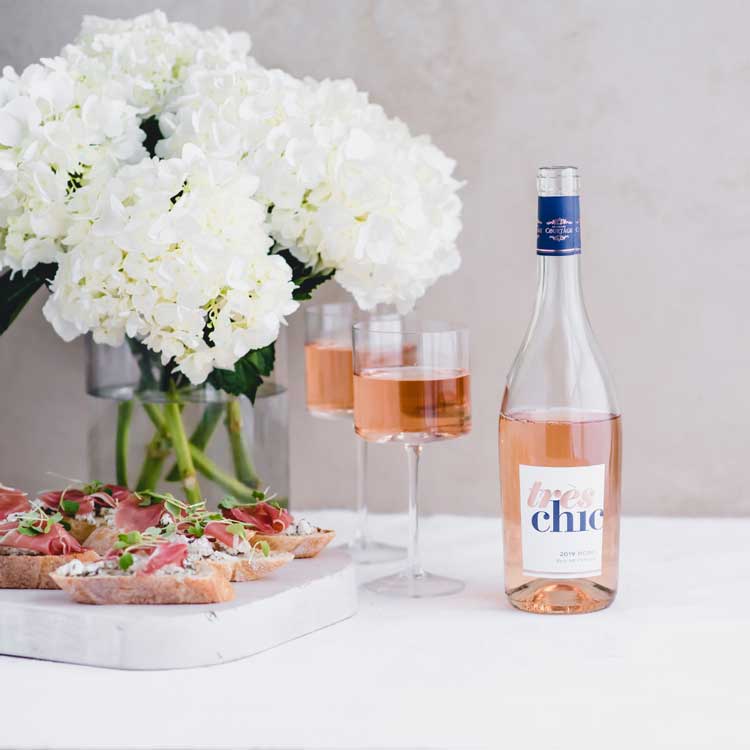
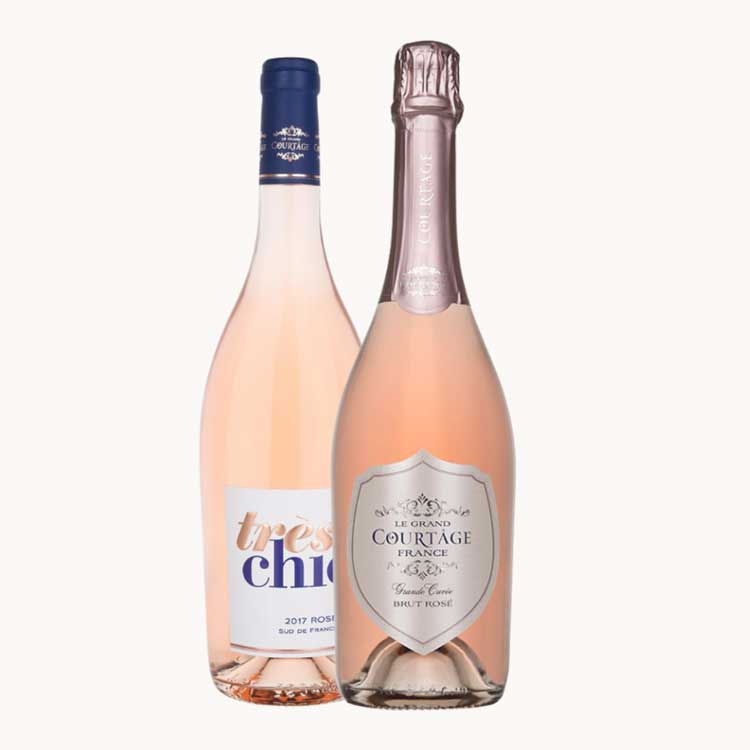
The bottom line – Rosé wines are diverse, and not quite as light as most white wines, but much brighter and lighter bodied than red wines. It is the perfect beverage to satisfy a wide range of palates. It’s cuisine, cocktail and consumer friendly and enjoyable to share with friends, at social gatherings, weddings, picnics, pool parties, or while relaxing in a bubble bath, after all, Rosé all Day!
More Blogs
- Embrace the Joys of Life: How French Sparkling Wine Elevates Your Senses
- What is the difference between sparkling wine and Champagne?
- An American Insider’s Guide to Visiting Paris: The Arrondissements, Maps, Getting Around & What to Know Before You Go
- How to Open a Bottle of Champagne or Sparkling Wine
- 31 Famous, Favorite and Fun Champagne Quotes
- How to Sabre a bottle of Champagne: Mastering the Art of Sabrage
- How To Drink Rosé: Do’s and Don’ts
- How Rosé Wine Is Made
- DIY VISION BOARD TO EMPOWER YOU IN 4 STEPS
- Sparkling Wine and Cheese Pairing
